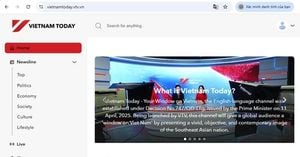Marketing strategies are constantly trying to catch up with the latest trends, and as brands evolve, their choice of platforms for advertising experiences has also transformed dramatically. One platform showing impressive growth is Roblox, the immersive gaming environment where users can create their own unique experiences. The rise of programmatic advertising within Roblox poses both new opportunities and challenges for game developers currently residing within this burgeoning market.
Traditionally, marketers have invested huge amounts of money in bespoke brand activations on Roblox—hundreds of thousands of dollars to create branded games. These high-budget, tailor-made experiences like "Barbie DreamHouse Tycoon" or "Walmart Discovered" have long dominated the advertising practices on the platform, allowing brands to engage directly with users within immersive worlds. An array of studios emerged to cater to this demand, with several becoming official Roblox partners last year.
Despite these custom investments, much of the advertising revenue went straight to the creative studios rather than Roblox itself. But this is shifting as Roblox has actively pivoted to incorporate programmatic advertising, launching its programmatic video ad business in May. This new initiative enhances the company's advertising revenue potential and allows marketers to engage with audiences more efficiently. The question on everyone’s minds is how this transition will affect the existing ecosystem of developers who relied heavily on bespoke projects.
The urgency for Roblox to adopt programmatic advertising is underscored by industry experts. Gareth Sutcliffe, head analyst for the games industry at Enders Analysis, remarked, "For Roblox, I don’t believe they really have any choice at this point other than to offer it as an option, especially with their financial situation." And he’s right, the platform has faced pressure to meet market demands as competition intensifies.
Roblox is not merely adding features for its own financial gain. They're also investing heavily in community building and attracting third-party developers through initiatives like the Roblox Partner Program. Roblox aims to draw savvy content creators to keep engaging consumers continually. Ashley McCollum, head of advertising strategic partnerships at Roblox, expressed this sentiment clearly: "Growing economic opportunities for our community developers remains very important … our developer community’s success is instrumental for the long-term health of the Roblox platform."
While many content creators agree with the potential for programmatic ads, they also recognize the new competition this brings. The developers worry some brands might opt for less engaging programmatic campaigns rather than fully immersing themselves with customized creations, which could divert significant funds away from bespoke experiences. For creators like Ricardo Briceno at Gamefam, there’s a dual approach wherein educational efforts are needed to clarify the strengths and weaknesses of both programmatic and immersive experiences. Briceno pointed out, "Once brands start to execute with lower barriers to entry, they’ll become more familiar with the platform and its nuances," which could encourage hybrid engagements.
It’s interesting to note how Roblox’s market mirrors platforms like YouTube, where brands frequently balance advertisements with custom content. McCollum pointed out, "The budgets for building immersive experiences are pretty different from media buying or programmatic budgets … These separate budgets work together, not against each other." It implies the evolution of brand marketing strategies must now accommodate both avenues of connection: the more traditional immersive experiences and modern programmatic ads.
Developers like Nic Hill from Sawhorse Productions are hopeful about the future. Hill noted, "The near future will offer so many different ways to activate; it gives brands more options." His own experience with the recent launch of the "Beetlejuice Beetlejuice" project is proof of how brands can adopt complementary strategies effectively, combining immersive activations with smartly placed programmatic ads to maximize reach.
Despite some initial concerns, it appears Roblox studios largely favor the programmatic ad rise. The hope is it will attract more brands to engage with the platform's offerings, lowering barriers for those hesitant to go all-in on bespoke experiences. The competition might be fierce, but many believe it’s healthy. Briceno emphasized, "There’s much bigger risk for brands to not go on Roblox because it’s too ‘new’ or ‘intimiditating’." So the push is for brands to get their feet wet and learn the ropes within this rapidly developing environment.
The integration of programmatic advertising indicates Roblox is pushing for broader acceptance as it transitions from being seen strictly as a video game to more of a multi-faceted platform for virtual interactions across various channels. Like any maturation process, there will be friction, but the end result could yield substantial rewards for both marketers and developers.
The future is bright, and as this technology develops, it’s safe to say we’re just scratching the surface of what’s possible within the realms of programmatic advertising on Roblox. The effective collaboration between immersive marketing and programmatic strategies could redefine how brands engage with audiences, ushering the gaming platform firmly through the gates of the mainstream advertising world.



